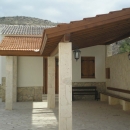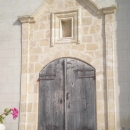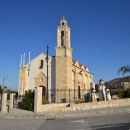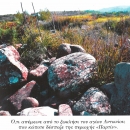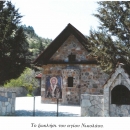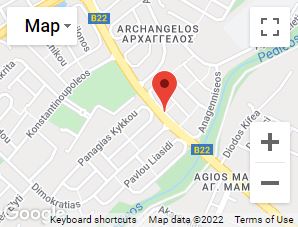There was a church of St. Paraskevi in the village, which was ruined and then reconstructed. It is today’s church of “Agia Paraskevi”.
Baptisms are conducted there and it is also officiated on the 26th of July, the saint’s day of St. Paraskevi.
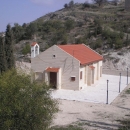

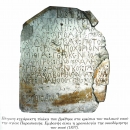
“Agioi Iliofotoi” is a small country-church, found next to the village of Kato Moni, in Mitsero. It is built upon the mountainside of the Koroni Mountain. The country-church was constructed around 1750 AD. Its inauguration was conducted in 1813 AD.
These Saints were 300 “Alamanoi” (plural, means German but generally refers to central & western Europeans) and had gone to Jerusalem in order to free it from the barbarians. After defeating them, the Saints went to the desert by the Jordan River, found a ship there and went aboard in order to return to their motherland, Allemande. But the winds were strong and their ship arrived to the island of Cyprus, in the harbour of Pafos.
Then the Saints scattered in all the areas of Cyprus. Five Saints came to the venue of the Koroni Mountain. They were the Saints Iliofotos, Epafroditos, Ammonios, Choulelaios, and Efsthenios.
The Saints had a large flock of sheep. With the plenty of milk that they produced, they started structuring their cave. However, one cannot build a cave with milk. They were building during the daytime and by night-time it collapsed. This happened three times until one day the Saint that was building the cave became angry, threw away his trowel and hit a rock. Water came out of that spot and so they were able to structure the cave in which the Saints’ tombs now rest. Later on, that water was transferred further below with pipes and a fountain was created. This is the Holy Water of the Iliofotoi Saints.
The Saints had many sheep. One day one of the Saints stood by the gate of the sheepfold, waiting for the only male sheep, which had a golden bell around its neck, to enter. Once it was in he closed the gate and said:
“Those inside …tame, and those outside…wild”. Immediately those that were outside were turned into mouflons [in Greek “agria” (plural) means wild and “agrina” means mouflons / ovis orientalis]. The Saints lead an ascetic life in the Koroni Mountain until their deaths.
However, after many years, a priest from Malounta named Papacharalampos, who had sarcomas on his hands, heard that someone had stolen some of the Saints’ remains from their tombs. So, he went to pay tribute to the Saints’ remains and see if they were missing. Indeed he saw that skulls and other parts of the remains were missing and was very sad. During the night, after officiating he went to sleep for a while. He the saw a vision of five men that were soldiers and told him to make a small box so as to keep the rest of the remains. He cut out a chest and went to the Saints’ tombs. He prayed with all his heart and immediately started to carefully place the remains inside. After some time he looked at his hands and there were no sarcomas on them, because he had touched the Holy remains. The Archbishop then decided to build a church in their honour and so it was done.
The Saints are commemorated on the 13 th of July. This country-church is extant until today and the inhabitants of Kato Moni officiate it on Easter Monday and on the Saints’ Day. Parts of the Saints’ remains are found in the church. The rest that remained are found in the church of Malounta. On the eve of the Saints’ Day a big fair takes place.
The Saints’ milk-pail in which they placed the sheep’s milk is extant as well as the fountain with the Saints’ Holy Water, flowing in abundance. At the same time, the community of Kato Moni receives its water supply from it.
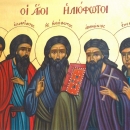

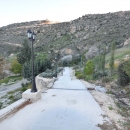
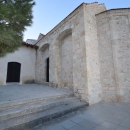
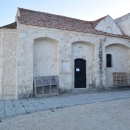


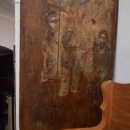
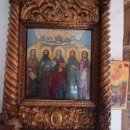
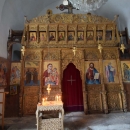
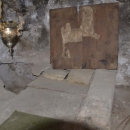
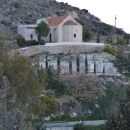
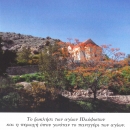
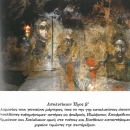
The church in Kato Moni is dedicated to the Saviour’s Transfiguration (” Metamorfosi tou Sotira “). The church is located at the centre of the village. The priest’s wife Christina Papagiorki -from Platanistasa -built it in 1880 after a donation. The first liturgy conducted in the church was done in 1901. His Eminence, the Coro-episkopos (suffragan Bishop) of Salamina, conducted its inauguration on the 1st of October 1948.
The church is built in gothic style.
In the area where the church stands there used to be another church, which was ruined. Afterwards, when they were constructing today’s church they were building over the old one.
There’s this tradition, regarding the building of the church, saying that the workmen constructing the church reported one day to the priest’s wife, Christina, that all the money were spent and that they needed money for the purchase of materials. So, the priest’s wife told them to go on working and that she would take care of things. She arranged that come Monday morning, when they started working, they would find money in a box so as to get paid and buy the materials necessary for the construction of the church. And so it was done.
The village’s church is large and it is located in the centre of the village, next to the Youth Centre. The church’s floor was originally made of stones, afterwards being covered by marble.
Operations for the church’s reparation and the modulation of its yard, which was paved with local stone, started on October 2003.
